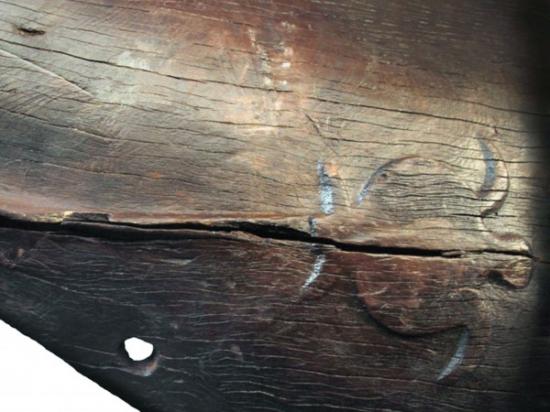Dennis Normile
Source - http://news.sciencemag.org/archaeology/2014/09/unusual-climate-gave-polynesian-explorers-boost

A sea turtle carved in raised relief on an early wood voyaging canoe. Turtles are rare in pre-European New Zealand carvings. IMAGE COURTESY OF TIM MACKRELL, CONSERVATION LABORATORY, THE UNIVERSITY OF AUCKLAND
Polynesian seafarers colonized Pacific islands stretching from Samoa and New Zealand to Easter Island and Hawaii centuries before Europeans discovered that ocean. But the details of when and how the Polynesians managed to traverse such vast stretches of open water are little understood. Now, a new archaeological find illuminates the construction of Polynesian canoes, while a study of ancient climate patterns bears on a long-standing debate about when Polynesians acquired the capability to sail into the wind.
The first piece of the puzzle is a fragment of a wooden canoe found in 2012 near the Anaweka River on the northwest coast of New Zealand's South Island. The 6-meter-long plank is likely part of a hull of a canoe that was originally up to 20 meters long and either had two hulls connected by and supporting a deck or had an outrigger—a sort of minihull connected to the canoe by arms—that provided stability. Radiocarbon dating indicates the canoe made its last voyage around 1400, and researchers believe it was built in New Zealand because it was constructed with wood from trees native to the islands. But two features suggest a strong tie to Polynesia. The plank has ribs carved into the inside face that suggest the craft's structure resembled a similar-aged canoe from the Society Islands, more than 4000 kilometers to the northeast, the authors report in a paper published online today in the Proceedings of the National Academy of Sciences (PNAS). The plank also has a relief carving of a sea turtle that would have been toward the rear of the craft just above the water line. Such turtles are common artistic motifs among the Polynesians but rarely appear in art native to New Zealand.
The second paper addresses a debate over whether Polynesian craft could have fought the winds to travel east. Now, winds in the tropical and subtropical Pacific are easterlies—that is, blowing from east to west; further south, westerlies prevail. Some scholars have taken these wind patterns to mean that Polynesians must have been capable of sailing into the wind to have traveled east from Samoa and the Central Pacific islands southwest to New Zealand. But canoes with that capability apparently only appeared centuries after the Polynesian colonization of those islands. So how did the first explorers get there? In the new study, a group led by Ian Goodwin, a climatologist at Macquarie University in Sydney, Australia, has concluded that Polynesian sailors might not have had to deal with the challenge of easterlies after all. Because of shifting climate conditions, there were several decades-long windows of opportunity in which Polynesian seafarers could have sailed with the wind at their backs to travel east and other times when winds favored travel between the Central Pacific islands and New Zealand. "Our reconstructed sailing conditions during the period of East Polynesian colonization would have enabled all of the known colonizing routes, and others,” to have been successfully navigated by canoes that couldn’t sail into the wind, the authors report online today, also in PNAS. And those favorable winds prevailed during precisely the periods when archaeological evidence indicates Polynesian colonization occurred. The wind reconstructions, based on new data about past climate, also suggest that Polynesian long-distance voyaging declined after 1300 because the winds shifted to their current patterns.
The canoe paper "is very exciting," says Andrew Lorrey, a paleoclimate specialist at New Zealand's National Institute of Water and Atmospheric Research in Auckland. The study enriches the "prewritten history of [New Zealand] and Pacific archaeology in general," he adds. And the paper on wind patterns presents "a very important result and has implications not only for when settlement might have occurred, but also for return voyaging [of explorers] to tropical Polynesia," says Bruce McFadgen, an archaeologist at Victoria University of Wellington.
They both caution that questions remain. For one thing, the wind patterns paper claims the climate window for sea voyaging to and from New Zealand closed well before 1300, though the canoe is dated to 1400. "There is a timing discrepancy," says Dilys Johns, an archaeologist at the University of Auckland, who is first author on the canoe paper. She says there is a possibility that the New Zealand canoe builders used traditional techniques passed down through generations long after they lost contact with Polynesia. Lorrey also notes that there could be uncertainties in the radiocarbon dating.
Still, the papers don't settle the question of whether the Polynesians of that age could sail into the wind. Answering that question, McFadgen says, "will test the ingenuity of future archaeological research.”